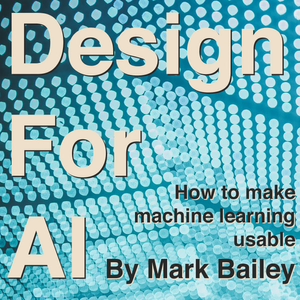
4-Improving the UX of conversational UIs
09/25/19 • 13 min
Episode 4
We cover all the steps needed for creating a conversational UI like a chatbot or Siri, Alexa, Google voice, and Cortana. We make sure to cover making a plan so a good user experience is the top priority.
Music: The Pirate And The Dancer by Rolemusic
Transcripts
Hello and welcome to Design for AI, I’m Mark Bailey, Welcome to episode 4
Let’s talk conversational UI.
A lot of people think chatbot, other people think Siri, Alexa, Google Voice, or Cortana.In the current gold rush climate that is AI right now, it seems that the first step a lot of companies dip their toe in. Sounds like a good topic to cover to me. So I’ll cover the steps that need to be covered to avoid mistakes.
1st step: start with a plan.
If you want to have a conversational interface you need a plan. Think of a good plan as a stop off point on way to voice interaction that everyone says is just around the corner. More likely though is to think of the plan as a list of immediate needs, then turn that around and look at it from the users point of view. Who uses a conversational UI? People using voice interfaces right now, they don’t want to be bothered. They don’t want to be bothered to wait to talk to a live person, bothered by downloading your app, bothered by opening their computer, not even bothered to get off the couch. Your UI needs to make their life more convenient. the way to think of your plan is, how will you get what you need AND make it more convenient for the user?
The first part of the plan is how this benefits your company. What is your motivation for building the interface. Your reason will be specific to you. So I can only cover the general cases. It could be for improving media buy by understand customers, or reducing call center time. There are a lot of Industry specific choices. Conversational UIs are easier to apply to certain industries more than others. Some of the easy industries for this kind of interface. If you are running a CRM, then reduce call center times. For IP established media, the personality is already there. There are set expectations on what to expect so it makes the personality a lot easier.
The next part of coming up with a plain is deciding what to measure. Again this is very specific to your industry. Do you want to know the length of engagement? should it be higher or lower? Do you want to increase return users A lot of the time you will be getting some analytics about the user. Do you want to compare info gathered through your UI to analytics info in user profile? What can you add to the user profile? Do you want to increase the number of recommendations made to other people. No I’m not talking about Net promoter score. I’m talking about use referral codes to get real numbers. You can even measure emotions on users leaving.
Once you have your plan
The next step you need is a DMP – Data management platform, to store the info you are collecting from your app. If you do not have one, now is the time to create it. You probably want to hire a data scientist because DMPs can have a high noise level. Because really, to get any usefulness out of them you will need to be running experiments with the data. DMPs work better better when cross referencing information against each other instead of straight search. Also now is the time to try rolling your own natural language processing project, known as a NLP. Siri, Alexa, Google voice, Cortana all have their own sandboxes that are not compatible with each other. You can try developing for a couple of them to see the differences between the systems. Or a good one open source one to get started with is called Mycroft.
So now that you have a plan and a platform to move forward with, what’s next? You need to create a personality. This is going to depend heavily on your company brand, and what you are trying to accomplish. Think of what is going to be the motivation for the AI you are building. What their motivation is will affect how they answer and guide the conversation. It also depends of the situation your users will be in while having the conversation. You don’t want a mechanic in the middle of a job getting asked 100 questions to get the response they want just so they don’t need to clean off their hands . It might sound like we are designing a person, and there is an argument that goes back and forth on how human you should make your your AI. It is too much to talk about here so I will cover that in a future episode.
short story is don’t fake being a real person. Also know that personality and humanness are different. In this case we want a strong personality, so what’s motivating your AI to give the answers it gives is important. A strong personality is important because it helps to hide the holes in the AI, but not in th...
Episode 4
We cover all the steps needed for creating a conversational UI like a chatbot or Siri, Alexa, Google voice, and Cortana. We make sure to cover making a plan so a good user experience is the top priority.
Music: The Pirate And The Dancer by Rolemusic
Transcripts
Hello and welcome to Design for AI, I’m Mark Bailey, Welcome to episode 4
Let’s talk conversational UI.
A lot of people think chatbot, other people think Siri, Alexa, Google Voice, or Cortana.In the current gold rush climate that is AI right now, it seems that the first step a lot of companies dip their toe in. Sounds like a good topic to cover to me. So I’ll cover the steps that need to be covered to avoid mistakes.
1st step: start with a plan.
If you want to have a conversational interface you need a plan. Think of a good plan as a stop off point on way to voice interaction that everyone says is just around the corner. More likely though is to think of the plan as a list of immediate needs, then turn that around and look at it from the users point of view. Who uses a conversational UI? People using voice interfaces right now, they don’t want to be bothered. They don’t want to be bothered to wait to talk to a live person, bothered by downloading your app, bothered by opening their computer, not even bothered to get off the couch. Your UI needs to make their life more convenient. the way to think of your plan is, how will you get what you need AND make it more convenient for the user?
The first part of the plan is how this benefits your company. What is your motivation for building the interface. Your reason will be specific to you. So I can only cover the general cases. It could be for improving media buy by understand customers, or reducing call center time. There are a lot of Industry specific choices. Conversational UIs are easier to apply to certain industries more than others. Some of the easy industries for this kind of interface. If you are running a CRM, then reduce call center times. For IP established media, the personality is already there. There are set expectations on what to expect so it makes the personality a lot easier.
The next part of coming up with a plain is deciding what to measure. Again this is very specific to your industry. Do you want to know the length of engagement? should it be higher or lower? Do you want to increase return users A lot of the time you will be getting some analytics about the user. Do you want to compare info gathered through your UI to analytics info in user profile? What can you add to the user profile? Do you want to increase the number of recommendations made to other people. No I’m not talking about Net promoter score. I’m talking about use referral codes to get real numbers. You can even measure emotions on users leaving.
Once you have your plan
The next step you need is a DMP – Data management platform, to store the info you are collecting from your app. If you do not have one, now is the time to create it. You probably want to hire a data scientist because DMPs can have a high noise level. Because really, to get any usefulness out of them you will need to be running experiments with the data. DMPs work better better when cross referencing information against each other instead of straight search. Also now is the time to try rolling your own natural language processing project, known as a NLP. Siri, Alexa, Google voice, Cortana all have their own sandboxes that are not compatible with each other. You can try developing for a couple of them to see the differences between the systems. Or a good one open source one to get started with is called Mycroft.
So now that you have a plan and a platform to move forward with, what’s next? You need to create a personality. This is going to depend heavily on your company brand, and what you are trying to accomplish. Think of what is going to be the motivation for the AI you are building. What their motivation is will affect how they answer and guide the conversation. It also depends of the situation your users will be in while having the conversation. You don’t want a mechanic in the middle of a job getting asked 100 questions to get the response they want just so they don’t need to clean off their hands . It might sound like we are designing a person, and there is an argument that goes back and forth on how human you should make your your AI. It is too much to talk about here so I will cover that in a future episode.
short story is don’t fake being a real person. Also know that personality and humanness are different. In this case we want a strong personality, so what’s motivating your AI to give the answers it gives is important. A strong personality is important because it helps to hide the holes in the AI, but not in th...
Previous Episode

3-How to use privacy to improve the UX of your AI apps
Episode 3
I talk about how to get privacy to improve the UX through federated learning.
- Google announcement for Federated learning
- Apple announces privacy for their AI models using Differential Privacy
Music: The Pirate And The Dancer by Rolemusic
Transcripts
Hello and welcome to Design for AI
Im Mark Bailey, Welcome to episode 3
Today we will be talking about federated learning.
There is a good chance some of you are wondering what it means,
don’t worry it’s still considered a pretty new topic in AI.
Even the word isn’t pinned down, Apple calls it ‘Differential Privacy’.
so I’ll jump right in to explaining what it is and why it’s important to UX.
The old way, or I guess I should say the normal current way,
most models store data used for machine learning
is to round up all the data you think you’re going to need + data attached to it
then all gets uploaded and stored on your servers.
This is the centralized model
There is the saying going around that data is the new oil,
because the more data you can get your hands on
then the better the accuracy is for your model.
Which means you’re at the front of the line for the gold rush,
right?...
Well, not so fast
There are problems
Some people refer to data as the new plutonium, instead of the new oil
There is a high liability for personal data
Releasing an app over the internet is global.
But, laws and regulations change by country.
The new EU privacy laws like the GDPR conflict with the laws in authoritarian countries where they want you to share all your data.
In steps the idea of federated learning
As a quick side note, I am using Google’s term federated learning,
instead of Apple’s term Differential Privacy.
Differential Privacy is a little more inclusive of making things outside of machine learning models private,
so in the interest of keeping things as specific as possible I’ll use the term federated learning
to keep things as specific as possible.
I’ve included links for both Apple and Google’s announcements in the show notes.
Anyway, it is easiest to think of it in terms of using a cell phone,
because that is where all of this got its start for both companies
On device storage is small and there is too much data to upload over a slow network
The phone downloads the current AI model.
Then it improves the model by learning from all the local data on your phone.
Your phone then summarizes the changes as a small update.
Only this small update is sent back instead of all the data.
For a non-phone example think of Tesla building their self driving cars.
Every car that Tesla is currently making records 8 different cameras every time that car is driving.
Those video feeds help to train the model Tesla is trying to create for the car to drive itself.
To date Tesla has sold over 575,000 cars since 2014 when they added the cameras needed for self driving.
multiple 575,000 by 8 then multiply that by the number of miles all those cars drive.
It becomes obvious that is just too many video feeds to send over their wireless network
much less to record and store on central servers somewhere.
More importantly, no one wants everywhere they have driven,
and every mistake they made to come back to haunt them.
federated learning allows Tesla to push the model out to their cars.
Let the model be trained by data collected in the car,
then the training corrections are sent back to Tesla without needing to send hours upon hours of video.
Privacy and data bandwidth are preserved.
As a side note, Tesla does upload some video of a car’s driving for things like accidents.
We talk about outliers and making which parts you keep private later.
So, federated learning allows for global results from local data.
Basically train on the local device and send aggregated results back
It allows to keep the sensitive data on device
and if you can promise, and deliver, privacy to the user of an AI model
then you have taken care of one of the biggest fears users have for machine learning.
Think about it, keeping my data private is one of the biggest complaints against people wanting to use AI.
It is right up there with robots taking over the world,
If we can solve real fears now, we can start working on the science fiction fears next.
This is why it is important to UX
All the benefits of privacy for your customers,
plus all the benefits for the company of well trained models.
Of course offering privacy t...
Next Episode

5-Michelle Carney, founder of MLUX
Episode 5
I talk with Michelle Carney, founder of MLUX. Lecturer for AI design at d.School at Stanford, and Sr UXR at Google AIUX group. We discuss resources available and needs that have not been filled yet
Upcoming Events:
Machine Learning and UX (MLUX) Meetup Resources:
- Google’s People + AI Guidebook
- MLUX meetup (you can see all of our past talks here!)
- MLUX youtube (all of our past recordings!)
- MLUX twitter (@mluxsf)
- MLUX linkedin company page, community group
- MLUX patreon (All of their events are FREE and they’re trying to get others who might not have access opportunities to speak to our community!)
Music: The Pirate And The Dancer by Rolemusic
Transcripts
Coming soon
If you like this episode you’ll love
Episode Comments
Generate a badge
Get a badge for your website that links back to this episode
<a href="https://goodpods.com/podcasts/design-for-ai-5017/4-improving-the-ux-of-conversational-uis-194532"> <img src="https://storage.googleapis.com/goodpods-images-bucket/badges/generic-badge-1.svg" alt="listen to 4-improving the ux of conversational uis on goodpods" style="width: 225px" /> </a>
Copy




